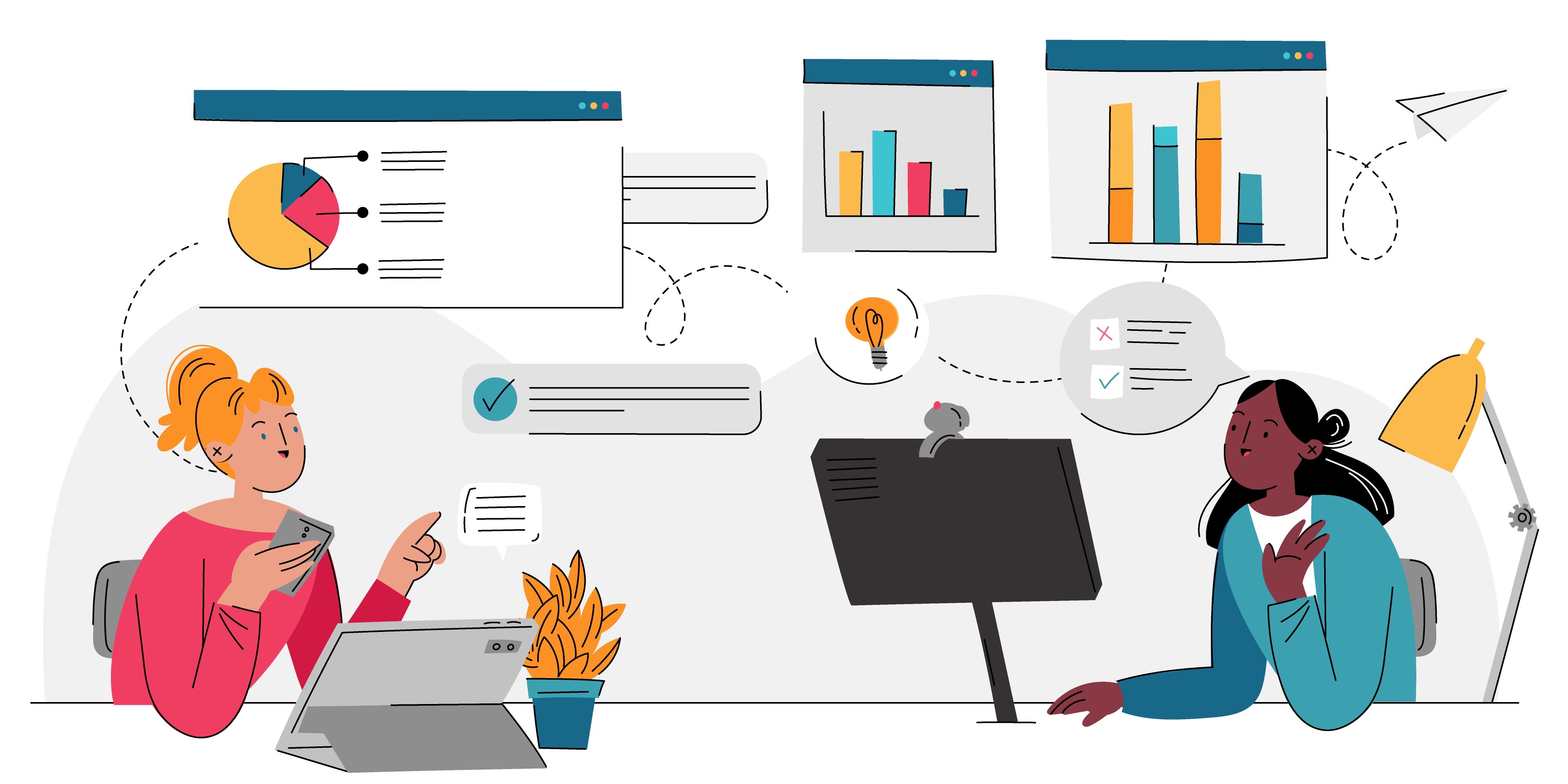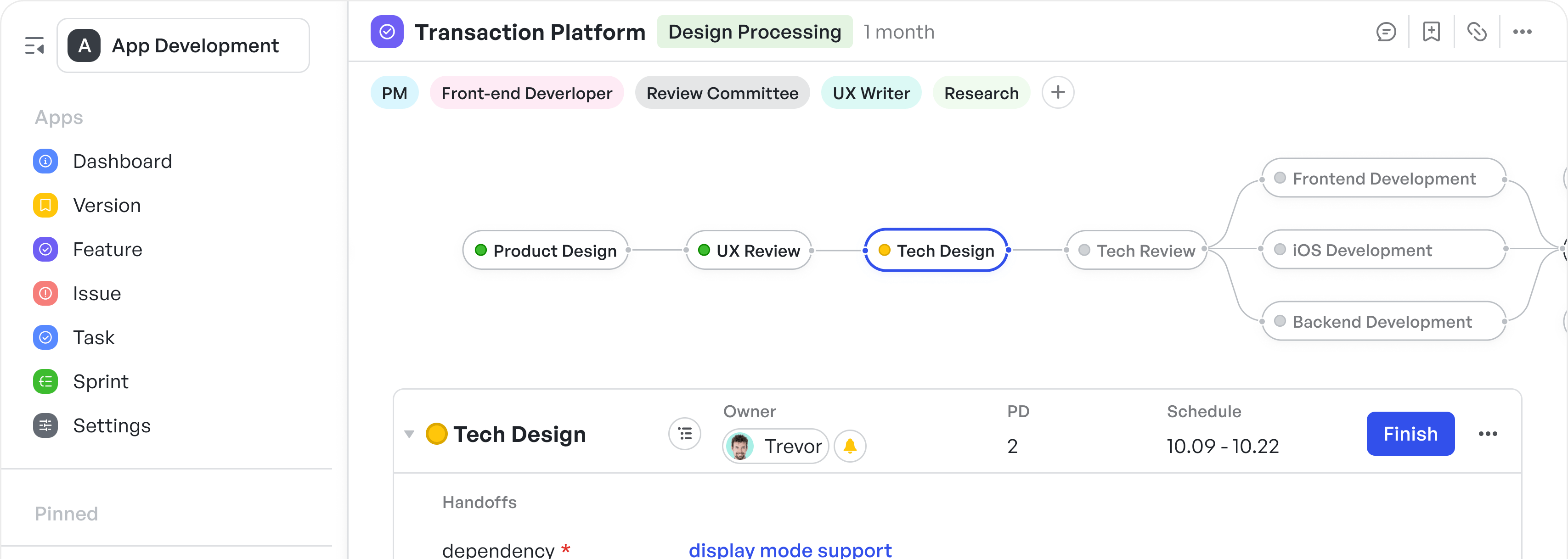Professionals across all departments increasingly find themselves in charge of projects, regardless of their official title or background. A PMI survey shows that about 61% of companies provide employee project management training.
The same study also indicated that managing projects effectively is a vital skill for career success, with organizations wasting almost 11.4% of their investment in project spending last year due to poor project performance.

250px|700px|reset
The learning curve can be steep, and the stakes are high for non-project managers suddenly tasked with overseeing complex initiatives.
By understanding key project management strategies and techniques, anyone can develop the skills to lead their teams to successful outcomes. This article outlines the key concepts and best practices every accidental project manager should know.
Comparing the top project management tools for non-project managers
Best project management tools for non-project managers in 2025
- Meegle: Simplified project management
- Project Central: Simple and effective
- Graduate Northeastern: For educational projects
- Management Concepts: Project management courses
- monday.com: Versatility meets simplicity
- American Management Association (AMA): For project management workshops
- Kissflow: Process automation and workflow management
250px|700px|reset
加载中,请稍后
Meegle project management software
Best for
- Teams that are looking for a comprehensive, customizable solution that accommodates various working styles.
Managing projects can feel overwhelming for non-project managers, especially when juggling multiple tasks without formal training. Meegle bridges the gap, offering tools designed specifically to make project management intuitive, efficient, and stress-free for non-project managers. It’s built to help you manage your work without needing a PMP certification.
Meegle’s key features
As a non-project manager, you may have a stubborn yet basic problem you need to place an effective patch on so you can focus on other aspects of your business processes.
Meegle is equipped with features to help you handle some common problems you may encounter, ranging from;
“Our creative assets are all over the place, and we don’t know where the bottlenecks are until it's late.”
Managing and accessing project-related assets can be cumbersome when they are scattered across different platforms.
In Meegle, all assets, images, videos, and logos (relevant task elements) are linked to their projects. This works well to facilitate faster asset retrieval and reduce time waste.
Also, complex projects can be hard to manage without a clear visual representation of progress and dependencies.
Meegle's node-driven workflows break down complex processes into orderly nodes and flows, forming a complete visual representation of the project. This helps team members understand the overall project better and see how their tasks connect to the bigger picture.
250px|700px|reset
加载中,请稍后
Meegle’s node-driven workflow design
You could be managing multiple projects but not realize that tasks are piling up in the QA stage until the deadline is days away. Meegle’s visual-first model allows you to see what's happening in real time so you can assign extra help before it causes delays.
Meegle’s advanced workflow visualization also offers multiple views, such as Gantt charts, Kanban boards, and timelines. These visual formats allow you to see the entire project lifecycle at a glance, making it easier to identify bottlenecks, set realistic deadlines, and ensure smooth project execution.
“How do I communicate? I’m constantly chasing updates from everyone.”
You spend half your day asking, “Hey, is the design ready? What’s the ETA for the email copy?”
With Meegle’s trigger-based automation, Meegle can send automatic notifications to relevant team members when specific events occur, such as a task status changing to 'In Progress.'
This keeps everyone informed without manual follow-ups, helping speed up task handoffs and project delivery.
250px|700px|reset
加载中,请稍后
Meegle syncs with communication tools like Slack
The second you assign a task, Meegle creates a chat group just for the people involved in the project. It also syncs with other communication tools like Slack.
This ensures that all discussions related to tasks and projects are centralized, reducing the need to switch between multiple communication tools.
250px|700px|reset
加载中,请稍后
Meegle creates group chats for projects
“Who’s doing what? Wait, did we miss a deadline?”
Sadly, ambiguity in roles and responsibilities can usually lead to tasks falling through the cracks. The idea is to clearly understand role definitions and task ownership throughout your team. Getting accountability sorted will lead to fewer mistakes and faster problem-solving.
With Meegle, your workflows have specific roles that can be assigned to each node or task, ensuring clarity in who is responsible for what.
For instance, in a video production workflow, roles like “Scriptwriter,” “Videographer,” and “Editor” can be clearly defined, and respective tasks can be assigned.
250px|700px|reset
加载中,请稍后
Meegle clarifies task ownership
Meegle allows teams to tailor workflows to their specific processes, ensuring that each stage of a project aligns with team roles and responsibilities.
“I’m not sure how best to share resources and manage workload.”
Without a clear overview, balancing workload and optimizing resource allocation can be challenging.
Meegle's calendar and chart display team member schedules and workloads, estimated by person-day (PD). You can go on to manage capacity planning in real time and allocate resources effectively based on team member availability.
250px|700px|reset
加载中,请稍后
Meegle workload distribution charts
Meegle also ensures that teams are promptly notified of any delays, displaying the exact number of days delayed and allowing for automated delay notification messages to relevant stakeholders.
“We keep wasting so much time on repetitive tasks.”
Manually assigning work for recurring tasks like campaign reports, asset approvals, and content reviews. It’s tedious, but you can avoid that with Meegle's no-code automation feature.
250px|700px|reset
加载中,请稍后
Meegle feature automation
Meegle enables users to set up triggers, conditions, and operations without writing any code.
For example, when a task status changes to 'Done,' Meegle can automatically assign the next task to the appropriate team member and send a notification. This creates better consistency with task execution, higher quality deliverables, and fewer missed steps.
“We need our existing tech stack to talk to each other.”
Meegle seamlessly integrates with popular tools like Slack, Zapier, and Github, ensuring you can manage your projects without disrupting existing workflows. These integrations make it easy for teams to collaborate, share updates, and stay connected, regardless of where they work.
250px|700px|reset
加载中,请稍后
Meegle integrates with third-party office applications
Meegle’s pros
- User-friendly interface: Easy navigation for non-project managers due to its intuitive design
- Comprehensive support: Extensive tutorials and customer support help users maximize the tool's potential
- Real-time updates: Ensures all team members access the latest project information, reducing miscommunication
- Flexible pricing plans: Offers plans to accommodate different budgetary needs
- Strong integration: Works seamlessly with other tools, enhancing functionality
- Scalable solution: Suitable for small teams and larger enterprises with complex projects
- Robust security features: Protects sensitive data with advanced measures.
Meegle’s pricing details
- Free: Up to 20 seats. For small teams to experience the magic of visual workflow
- Standard plan: $8/user/month, ideal for small-sized teams to optimize collaboration and manage projects effortlessly (billed annually)
- Premium plan: $12/user/month, ideal for mid-sized organizations to scale up project management and enhance team collaboration (billed annually)
- Enterprise plan: Custom pricing tailored for large organizations with specific needs (billed annually)
Our take
Meegle stands out with robust visualization tools and real-time collaboration capabilities, making it an excellent choice for non-project managers aiming to improve their skills. However, users should be prepared for a learning curve with advanced features.
250px|700px|reset
加载中,请稍后
Project Central project management tool - Source: ProjectCentral
Best for
- Small teams or individuals seeking a straightforward tool that is easy to use and affordable.
Project Central offers a simple and effective management tool for non-project managers who need to keep projects on track without complexity. Its straightforward interface allows quick project management initiation. Users can easily assign tasks, monitor progress, and access dashboards for a clear project status overview.
Project Central’s key features
- Task assignments: Easily delegate tasks with clear deadlines.
- Progress dashboards: Get a quick overview of progress through visual dashboards.
- Simple interface: Designed for ease of use.
- Team collaboration: Facilitates communication and collaboration.
- Time tracking: Monitor time spent on tasks and projects.
- Notifications and alerts: Stay informed about updates and changes.
- Document sharing: Share project documents and files.
Project Central’s pros
- Simplicity: Easy to use, even for those with no prior experience.
- Affordable pricing: Competitive pricing plans are accessible for small teams.
- Quick setup: Minimal setup time, ideal for fast-paced environments.
- Efficient task management: Helps keep projects organized and on schedule.
- Clear visuals: Provides a clear view of progress and timelines.
- Strong customer support: Responsive support helps users when needed.
- Customizable alerts: Tailor notifications to stay on top of updates.
Project Central’s cons
- Limited advanced features: May not offer enough depth for complex needs.
- Basic reporting: Reports are limited compared to advanced tools.
- Integration constraints: Fewer integrations are available.
- Mobile compatibility: Mobile functionality can be limited.
- Scalability issues: May not scale well for larger organizations.
- Customization options: Limited customization for dashboards and workflows.
Project Central’s pricing details
- Starter plan: $5/user/month, includes basic features.
- Professional plan: $10/user/month, adds advanced tracking and reporting tools.
- Premium plan: Contact for pricing.
Our take
Project Central is ideal for non-project managers looking for a simple way to manage tasks without complexity. Its affordability and ease of use make it a great option for small teams or those new to management.
250px|700px|reset
加载中,请稍后
Graduate Northeastern institution for project management - Source: Northeastern University
Best for
- Educational institutions looking to enhance management within an academic setting.
Graduate Northeastern offers a unique perspective on management, focusing on educational projects and collaboration among students and educators. It provides tools designed to enhance learning experiences and facilitate academic projects, helping students and teachers manage projects efficiently while fostering collaboration.
Graduate Northeastern’s key features
- Educational project management: Tailored tools for managing academic projects and assignments.
- Student collaboration: Facilitates teamwork and communication.
- Resource sharing: Easy access to educational resources.
- Progress tracking: Monitor progress and milestones.
- Teacher feedback: Allows educators to provide feedback on projects.
- Integration with LMS: Seamlessly connects with popular learning management systems.
- Customizable templates: Provides templates for common academic projects.
Graduate Northeastern’s pros
- Focus on education: Specifically designed for educational environments.
- Enhances learning: Encourages collaboration and engagement.
- Teacher involvement: Supports teacher-student communication.
- Accessible resources: Easy access to materials and resources.
- Customizable projects: Offers flexibility in setup and management.
- Support for academic goals: Aligns projects with educational objectives.
- Integration with LMS: Works well with educational platforms.
Graduate Northeastern’s cons
- Limited business applications: Primarily focused on educational projects.
- Complex setup for institutions: May require significant setup and integration.
- Dependence on LMS: Relies on integration with learning systems.
- Limited customization for non-educational use: Tailored for academic environments.
- Potential learning curve for new users: Training may be needed.
Graduate Northeastern’s pricing details
- Contact for pricing: Varies based on institution size and needs.
Our take
Graduate Northeastern excels in educational environments, offering tailored tools for managing academic projects. While unsuitable for traditional business use, these tools foster student collaboration and enhance learning.
250px|700px|reset
加载中,请稍后
Management Concepts training space for project management - Source: Management Concepts
Best for
- Professionals seeking to enhance skills through structured programs.
Management Concepts provides leadership training and courses designed to equip non-project managers with essential skills. With a focus on professional development, it offers programs covering basics, advanced techniques, and leadership strategies, enhancing capabilities and enabling effective project leadership.
Management Concepts’ key features
- Leadership training: Develop essential skills for managing teams.
- Project management courses: Offers a variety of courses covering fundamentals and advanced topics.
- Customizable training programs: Tailor programs to meet specific needs.
- Experienced instructors: Taught by industry experts.
- Certification programs: Provides recognized credentials.
- Interactive learning: Engages participants through workshops and exercises.
- Online and in-person options: Flexible formats to accommodate preferences.
Management Concepts’ pros
- Comprehensive training: Covers a wide range of topics.
- Industry expertise: Leverages seasoned professionals' knowledge.
- Flexible learning: Offers online and in-person options.
- Customizable programs: Tailors training to align with goals.
- Certification options: Provides opportunities for credentials.
- Interactive workshops: Engages participants through practical exercises.
- Supportive environment: Fosters a collaborative atmosphere for learning.
Management Concepts’ cons
- Pricing details: Course-specific pricing may require budgeting.
- Limited software tools: Focuses on training, not software.
- Time commitment: Courses may require significant time.
- Geographic limitations: In-person training may be location-limited.
- Focus on traditional methods: Emphasizes traditional practices.
- Potential cost consideration: High-quality training can be costly.
Management Concepts’ pricing details
- Course-specific pricing: Varies based on the course selected.
Our take
Management Concepts offers invaluable training for non-project managers who want to develop their skills. Their courses focus on professional development and provide practical insights and applications.
250px|700px|reset
加载中,请稍后
monday.com project management software
Best for
- Teams seeking a versatile and customizable tool.
monday.com is a versatile tool for a wide range of users, including non-project managers. Its user-friendly interface and customizable features make it ideal for streamlining workflows. With visual tracking and automation capabilities, monday.com simplifies management while providing insights into performance.
monday.com’s key features
- Visual project tracking: Offers tools like boards and timelines.
- Workflow automation: Automates tasks to improve efficiency.
- Customizable templates: Provides templates for different project types.
- Integration with tools: Connects with apps like Slack and Microsoft Teams.
- Collaboration features: Facilitates communication and collaboration.
- Time tracking: Tracks time spent for better management.
- Reporting and analytics: Offers insights through reports.
monday.com’s pros
- User-friendly interface: Easy for non-project managers to use.
- Flexible features: Customizable to suit different needs.
- Strong integration: Works seamlessly with other tools.
- Efficient task management: Simplifies assignments and tracking.
- Scalable solution: Suitable for teams of all sizes.
- Real-time updates: Keeps members informed.
- Comprehensive support: Offers extensive resources.
monday.com’s cons
- Pricing tiers: Can be expensive for larger teams.
- Complexity for new users: Features may be overwhelming at first.
- Limited offline access: Requires an internet connection.
- Customization constraints: Certain features have limitations.
- Learning curve for advanced features: May require time to master.
- Mobile app limitations: Mobile version lacks some desktop features.
monday.com’s pricing details
- Basic plan: $8/user/month, includes essential features.
- Standard plan: $10/user/month, adds advanced tools.
- Pro plan: $16/user/month, offers full access and reporting.
- Enterprise plan: Custom pricing tailored for large organizations.
Our take
monday.com is a powerful solution offering flexibility and customization. While its features can be extensive, its user-friendly interface makes it accessible for non-project managers.
250px|700px|reset
加载中,请稍后
American Management Association (AMA) project management workshop - Source: amanet
Best for
- Professionals seeking to enhance skills through structured programs
The American Management Association (AMA) provides workshops and training programs designed to enhance the skills of non-project managers. Focusing on practical applications, AMA offers courses covering essentials, advanced techniques, and leadership strategies, empowering individuals and organizations to achieve success.
AMA’s key features
- Project management workshops: Offers hands-on workshops.
- Leadership development: Provides training focused on leadership skills.
- Certification programs: Offers recognized credentials.
- Experienced instructors: Taught by industry experts.
- Flexible learning options: Provides online and in-person formats.
- Customizable solutions: Tailors programs to meet needs.
- Interactive learning: Engages participants through exercises.
AMA’s pros
- Comprehensive training: Covers a wide range of topics.
- Industry expertise: Leverages seasoned professionals' knowledge.
- Flexible learning: Offers convenient options.
- Customizable programs: Tailors training to align with goals.
- Certification opportunities: Provides credentials.
- Interactive format: Engages participants through exercises.
- Supportive environment: Fosters a collaborative atmosphere for learning.
AMA’s cons
- Course-specific pricing: Varies based on the course selected.
- Limited software tools: Focuses on training, not software.
- Time commitment: Courses may require significant time.
- Geographic limitations: In-person training may be location-limited.
- Focus on traditional methods: Emphasizes traditional practices.
- Potential cost consideration: High-quality training can be costly.
AMA’s pricing details
- Course-specific pricing: Varies based on the course selected.
Our take
The American Management Association (AMA) offers invaluable training for non-project managers who want to develop skills with a focus on practical applications.
250px|700px|reset
加载中,请稍后
National Institutes of Health (NIH) Office of Human Resources - Source: National Institutes of Health
Best for
- Government organizations looking to enhance skills and collaboration.
NIH HR provides internal resources and tools to enhance employee collaboration and skills. Focused on internal use within the National Institutes of Health (NIH), NIH HR supports effective practices and fosters employee collaboration through training programs.
NIH HR’s key features
- Internal resources: Provides tools for managing projects within NIH.
- Employee collaboration: Facilitates communication and collaboration.
- Training programs: Offers programs to enhance skills.
- Resource sharing: Easy access to materials.
- Progress tracking: Monitor progress and milestones.
- Leadership development: Supports development through training.
- Customizable templates: Provides templates for common projects.
NIH HR’s pros
- Focus on internal use: Tailored for internal use within NIH.
- Enhances collaboration: Encourages communication.
- Support for skills: Provides training and resources.
- Accessible resources: Easy access to materials.
- Customizable projects: Offers flexibility in setup.
- Support for development: Provides training and resources.
- Integration with systems: Connects with internal systems.
NIH HR’s cons
- Limited business applications: Primarily focused on internal use.
- Pricing details: Internal use, contact for access and pricing.
- Complex setup for large organizations: May require significant setup.
- Dependence on systems: Relies on integration with systems.
- Limited customization: Tailored for internal environments.
- Potential learning curve: Training may be needed.
NIH HR’s pricing details
- Internal use: Contact for access and pricing.
Our take
NIH HR provides resources and training for government organizations looking to enhance skills and collaboration. While not suitable for traditional business use, it excels in fostering internal collaboration.
250px|700px|reset
加载中,请稍后
Kissflow workflow management platform - Source: Kissflow
Best for
- Teams seeking a cloud-based tool with workflow automation and integration.
Kissflow offers a cloud-based tool for workflow automation and management. With a user-friendly interface and customizable workflows, Kissflow helps non-project managers streamline processes. Its integration capabilities make it versatile for enhancing practices.
Kissflow’s key features
- Workflow automation: Automates tasks to improve efficiency.
- Customizable workflows: Allows workflow customization.
- Integration with tools: Connects with apps like Slack and Google Workspace.
- Collaboration features: Facilitates communication.
- Reporting and analytics: Offers insights through reports.
- Form creation: Provides tools for creating forms.
- Mobile access: Allows management on the go.
Kissflow’s pros
- User-friendly interface: Easy for non-project managers to use.
- Flexible features: Customizable workflows to suit needs.
- Strong integration: Works seamlessly with other apps.
- Efficient task management: Simplifies assignments and tracking.
- Scalable solution: Suitable for teams of all sizes.
- Real-time updates: Keeps members informed.
- Comprehensive support: Offers resources and support.
Kissflow’s cons
- Pricing tiers: Can be expensive for larger teams.
- Complexity for new users: Features may be overwhelming initially.
- Limited offline access: Requires an internet connection.
- Customization constraints: Certain features have limitations.
- Learning curve for advanced features: May require time to master.
- Mobile app limitations: Mobile version lacks some desktop features.
Kissflow’s pricing details
- Basic plan: $10/user/month, includes essential features.
- Standard plan: $15/user/month, adds advanced tools.
- Pro plan: $20/user/month, offers full access and reporting.
- Enterprise plan: Custom pricing tailored for large organizations.
Our take
Kissflow offers powerful workflow automation and integration capabilities. Its user-friendly interface makes it accessible for non-project managers, while customizable workflows provide flexibility for different needs.
Effective techniques for non-project managers
- Define clear goals
- Define clear goals
Start every project by defining specific, measurable, achievable, relevant, and time-bound (SMART) goals. This ensures all stakeholders are aligned and focused.
250px|700px|reset
加载中,请稍后
- Prioritize tasks using the Eisenhower matrix
- Prioritize tasks using the Eisenhower matrix
Organize tasks by urgency and importance to focus on what matters most:
- Urgent & Important: Do immediately.
- Important but Not Urgent: Schedule for later.
- Urgent but Not Important: Delegate.
- Neither Urgent nor Important: Eliminate.
250px|700px|reset
加载中,请稍后
- Use Agile methodology
- Use Agile methodology
Adopt Agile practices like breaking work into smaller iterations (sprints) to complete tasks incrementally. This helps in adapting to changing priorities and reduces overwhelming workloads.
250px|700px|reset
加载中,请稍后
- Leverage visual management tools
- Leverage visual management tools
Utilize Kanban boards or Gantt charts to make workflows visible. This technique improves clarity, tracks progress, and ensures everyone knows their responsibilities.
250px|700px|reset
加载中,请稍后
- Communicate effectively
- Communicate effectively
Clear and consistent communication is key. Regular updates through meetings or project management tools keep everyone informed and aligned.
- Automate repetitive tasks
- Automate repetitive tasks
Tools like Meegle and monday.com offer automation features to handle repetitive tasks, allowing teams to focus on strategic priorities.
250px|700px|reset
加载中,请稍后
Automate repetitive tasks in Meegle
- Monitor performance and adjust
- Monitor performance and adjust
Review progress regularly through reporting and analytics tools. Make adjustments to timelines or resources to stay on track.
Why non-project managers should leverage software and techniques
- Improved efficiency: Streamline workflows and reduce time spent on manual processes.
- Better collaboration: Tools and techniques foster communication and alignment across teams.
- Scalability: Manage small tasks or large projects with ease.
- Professional growth: Learn new skills and enhance your ability to contribute to organizational success.
How to choose the right project management tool for non-project managers
Selecting the right project management tool is crucial for improving collaboration among team members and productivity. With numerous options available, here are key factors to consider when making your choice:
- Ease of use: Intuitive interface matters
- Ease of use: Intuitive interface matters
A project management tool should be easy to navigate, even for those without technical expertise. Look for a user-friendly interface with a clean design and simple onboarding processes. A steep learning curve can hinder adoption across your team, so prioritize tools that offer straightforward navigation and tutorials.
- Feature set: Aligning with your specific needs
- Feature set: Aligning with your specific needs
Not all project management tools are created equal. Evaluate the features offered by the tool and compare them to your needs. Common must-have features include task management, time tracking, reporting, document sharing, and workflow automation.
If you're managing complex projects, tools with advanced features like Gantt charts and resource management may be more suitable.
- Integration capabilities: Seamless app compatibility
- Integration capabilities: Seamless app compatibility
The ideal project management tool should integrate seamlessly with other applications your team uses, such as email platforms, CRM software, and communication tools like Slack or Microsoft Teams. Robust integration capabilities reduce the need to switch between apps, enhancing productivity and streamlining workflows.
- Pricing: Affordability and budget compatibility
- Pricing: Affordability and budget compatibility
Compare the pricing plans of different tools to find one that fits your budget without compromising essential features. Many tools offer tiered plans, including free options for small teams and premium plans for larger organizations.
Look for tools that provide a good balance of cost and value, and avoid paying for features you won’t use.
- Scalability: Growing with your needs
- Scalability: Growing with your needs
As your team or organization expands, your project management tool should be able to grow with you. Choose a tool that offers scalability, such as the ability to handle additional users, larger projects, or more advanced features as your requirements evolve.
- Support and resources: Reliable help when you need it
- Support and resources: Reliable help when you need it
Comprehensive customer support is essential, especially when introducing a new tool to your team. Look for tools that offer multiple support channels, such as live chat, email, or phone. Additionally, access to online resources like FAQs, knowledge bases, and video tutorials can help your team quickly resolve issues.
- Customization options: Tailoring to your workflow
- Customization options: Tailoring to your workflow
Every team has unique workflows and processes, so choosing a tool that allows customization is essential. This can include personalized dashboards, custom task statuses, or workflow automation rules. Customization ensures the tool adapts to your needs rather than forcing your team to adjust to its limitations.
Benefits of project management for non-project managers
Project management isn't just for seasoned professionals; it's an essential skill that can significantly benefit non-project managers by improving efficiency, collaboration, and overall work outcomes. Here’s how:
- Improved efficiency and productivity
- Improved efficiency and productivity
Project management tools and practices help streamline workflows by automating repetitive tasks, setting clear priorities, and ensuring team members focus on high-impact activities.
250px|700px|reset
加载中,请稍后
Meegle’s predefined templates
By reducing manual intervention and providing task templates, non-project managers can accomplish more in less time. This efficiency translates into measurable productivity gains, helping teams easily achieve deadlines
- Enhanced collaboration across teams
- Enhanced collaboration across teams
Effective project management fosters better communication and collaboration, even for teams working remotely or across different departments. Tools like task boards, shared calendars, and real-time messaging ensure everyone stays on the same page.
Non-project managers can rely on these systems to align team goals, share updates, and track contributions, resulting in smoother teamwork and fewer misunderstandings.
- Better resource allocation and management
- Better resource allocation and management
One of the biggest challenges for non-project managers is managing limited resources effectively.
Project management tools provide insights into resource availability and allocation, allowing managers to assign the right people to the right tasks. These insights help optimize team performance and prevent bottlenecks or overwork, ensuring project timelines are met without compromising quality.
- Increased accountability and ownership
- Increased accountability and ownership
Tracking task assignments and progress boosts accountability across the team. By clearly defining who is responsible for each task and setting realistic deadlines, project management eliminates confusion and ensures everyone contributes to the project's success.
This structure makes it easier for non-project managers to monitor team performance and address challenges proactively.
- Clearer visibility into project progress
- Clearer visibility into project progress
Visual tools like Gantt charts, Kanban boards, and progress reports offer a transparent view of where a project stands. This visibility allows non-project managers to identify potential risks quickly, adjust plans as needed, and provide accurate updates to stakeholders.
With better visibility, it’s easier to stay on track and make informed decisions to steer projects toward successful completion.
- Reduced stress and improved organization
- Reduced stress and improved organization
Managing projects without structure often leads to chaos and stress. Project management tools bring much-needed organization, enabling non-project managers to plan, prioritize, and execute tasks systematically. This structured approach reduces the feeling of being overwhelmed and provides clarity, making the work environment more manageable and enjoyable.
Why non-project managers should embrace project management practices
By adopting project management practices, non-project managers can unlock significant benefits, including improved time management, stronger teamwork, and better decision-making. Whether managing a single task or overseeing an entire initiative, these tools and techniques empower professionals to deliver exceptional results with confidence.
If you're looking for a comprehensive solution, tools like Meegle can help simplify your work, save time, and improve productivity. Embracing these systems is no longer a luxury but a necessity for thriving in today’s fast-paced work environment.
Meegle stands out as a comprehensive tool offering powerful visualization and collaboration features. Its user-friendly interface and customizable dashboards make it an excellent choice for enhancing skills.
FAQs
Q: What is the best tool for non-project managers?
A: The best tool depends on specific needs, but Meegle, with its intuitive interface and robust features, is a strong contender.
Q: Are there free tools available?
A: Yes, many tools offer free plans with basic features, such as Meegle, monday.com, and Project Central.
Q: How can tools benefit non-project managers?
A: They improve efficiency, enhance collaboration, and help manage resources.
Q: What should I consider when choosing a tool?
A: Consider ease of use, features, integration, pricing, scalability, support, and customization.
Q: Can tools integrate with other apps?
A: Yes, many tools offer integration with apps like Slack and Google Workspace.





